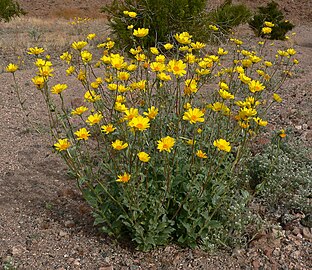en
names in breadcrumbs


The desert sunflower bears yellow sunflower-like flowers on slender, hairy stems. It gets its name from the Greek gerios meaning, “old man,” referring to its white hairs on its fruits. It is native to western America, where it is a drought evasion plant that dies off after producing seeds. It blooms during the raining seasons, in February-May or October- November. They stay dormant and re-germinate during the short rains in the fall.
The flowers have between 10-12 bright yellow petals, steaming from the small yellow disc in the middle. The fruits inside the flower are a good source of protein for bees.
Geraea canescens, commonly known as desert sunflower, hairy desert sunflower, or desert gold, is an annual plant in the family Asteraceae. The genus name comes from the Greek geraios ("old man"), referring to the white hairs on the fruits.[2]
G. canescens bears yellow sunflower-like flowers on slender, hairy stems. It grows 0.30–0.91 metres (1–3 feet) high. The leaves are gray-green and grow to 8 centimetres (3 inches) long. It flowers February through May after sufficient rainfall, and sometimes in October and November.[3] The flowers are 5 cm (2 in) wide with 10–20 ray florets, which are each about 2 cm (3⁄4 in) long.[3]
The plant is native to western North America, specifically Arizona, Nevada, California, and Utah. A drought-resistant annual plant, it can be found in the California,[4] Mojave, and Sonoran Deserts. It grows below sea level, from −40 to 1,130 m (−130 to 3,700 ft), in sandy desert soils along with creosote bush (Larrea tridentata).[5] It is one of the flowers which participates in the occasional superblooms of desert flowers.
There are two varieties:
The flowers attract bees and birds, and the seeds are eaten by birds and rodents.[6]
Geraea canescens, commonly known as desert sunflower, hairy desert sunflower, or desert gold, is an annual plant in the family Asteraceae. The genus name comes from the Greek geraios ("old man"), referring to the white hairs on the fruits.
G. canescens bears yellow sunflower-like flowers on slender, hairy stems. It grows 0.30–0.91 metres (1–3 feet) high. The leaves are gray-green and grow to 8 centimetres (3 inches) long. It flowers February through May after sufficient rainfall, and sometimes in October and November. The flowers are 5 cm (2 in) wide with 10–20 ray florets, which are each about 2 cm (3⁄4 in) long.
The plant is native to western North America, specifically Arizona, Nevada, California, and Utah. A drought-resistant annual plant, it can be found in the California, Mojave, and Sonoran Deserts. It grows below sea level, from −40 to 1,130 m (−130 to 3,700 ft), in sandy desert soils along with creosote bush (Larrea tridentata). It is one of the flowers which participates in the occasional superblooms of desert flowers.
There are two varieties:
Geraea canescens var. canescens Geraea canescens var. paniculata S.F.BlakeThe flowers attract bees and birds, and the seeds are eaten by birds and rodents.

G. canescens in Death Valley



Flower close-up

Seeds
Geraea canescens est une espèce végétale de la famille des Asteraceae.
Cette plante velue mesure entre 30 et 90 cm de hauteur. Elle forme des touffes de dimension variable. Les feuilles de 7,5 cm de long en moyenne peuvent être lancéolées ou ovales, entières ou garnies de quelques dents[1].
La floraison a lieu entre février et mai, mais les années où l'été a connu suffisamment d'averses, une deuxième floraison peut survenir entre octobre et novembre.
Les inflorescences sont des capitules jaunes, seuls ou en petit nombre au sommet de tiges florales. Chaque capitule mesure environ 5 cm de diamètre à maturité. Il est composé de 10 à 20 fleurons ligulés oblongs de 2 cm de long, entourant un disque central constitué de nombreux fleurons tubulaires. L'involucre situé sous le capitule est composé de bractées couvertes de long poils blancs, fins et raides[1].
Le fruit est un akène aplati, à la surface velue, et enveloppé dans une bractée parcheminée. Le fruit présente sur ses côtés une marge blanche et à son sommet deux écailles pointues.
Cette plante vit dans le sud-ouest des États-Unis et au nord-ouest du Mexique. Sa limite nord va de la Californie à l'Utah, sa limite est jusqu'au Texas.
Elle pousse sur les replats désertiques, arides et sablonneux. Elle peut être commune sur les bords de route.
Geraea vient du mot grec geraios, le « vieil homme », ce qui est une référence aux poils blancs qui couvrent ce genre de plantes[1].
Geraea canescens est une espèce végétale de la famille des Asteraceae.
Geraea canescens là một loài thực vật có hoa trong họ Cúc. Loài này được Torr. & A.Gray mô tả khoa học đầu tiên năm 1847.[1]
Geraea canescens là một loài thực vật có hoa trong họ Cúc. Loài này được Torr. & A.Gray mô tả khoa học đầu tiên năm 1847.